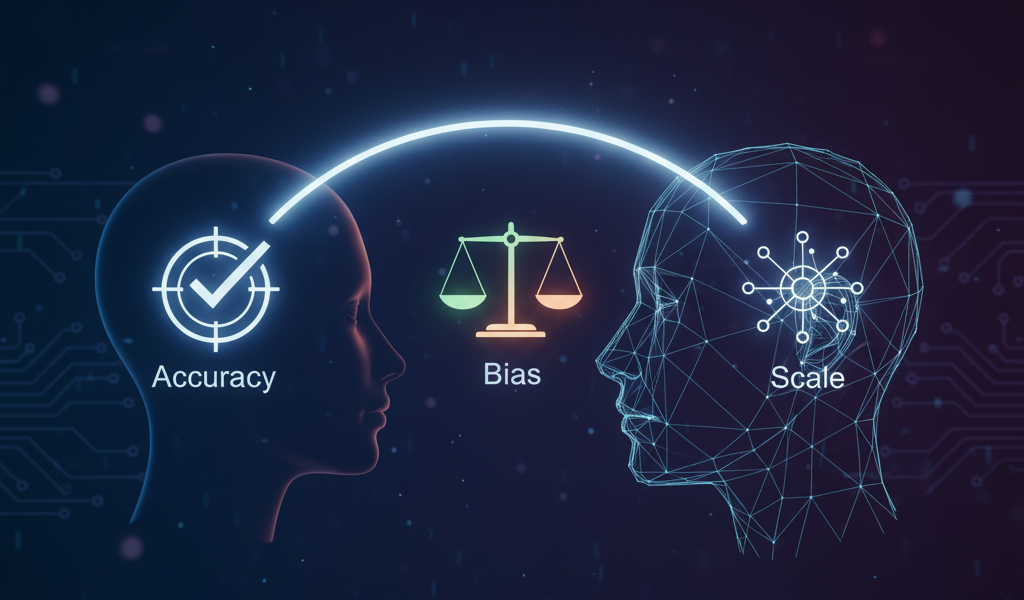
AI is shaping our future, but can we truly trust it? Discover why Accuracy, Bias, and Scale are the three pillars that decide whether AI succeeds or fails.
Artificial Intelligence (AI) is no longer a thing of the future—it’s already part of our daily lives. Think about the chatbot that answers your questions on a website, the “Recommended for You” section on Netflix or Amazon-like platforms, or even smart tools that help doctors detect diseases faster. We rely on AI more often than we realize.
Why AI Testing Matters
But there is one big question: how do we know that AI is working the way it should?
This is where AI testing comes in.
Just like we test software for bugs before release, AI needs its own form of testing. However, AI is different—it’s not just about “working” or “not working.” It’s about how well it works, how fairly it works, and how it performs under pressure.
At PIT Solutions, we help organizations test AI with these challenges in mind, ensuring their systems deliver results that are not only functional but also reliable and fair.
To make AI trustworthy, three pillars form the foundation of AI testing: Accuracy, Bias, and Scale.
Let’s go through them one by one.
Accuracy: Getting AI Right
The first pillar is accuracy. Imagine asking your voice or chat assistant, “What’s the weather today?” If it tells you it’s sunny when it’s actually raining outside, that’s not just annoying—it’s inaccurate.
In AI, accuracy means how close the output is to the truth.
- A medical AI tool must correctly detect diseases in scans.
- A fraud detection system should spot fake transactions without flagging genuine ones.
- A chatbot should provide relevant and meaningful answers.
The higher the accuracy, the more useful the AI. But accuracy isn’t always about being 100% correct—it’s also about being reliable and consistent.
▶ Why it matters: Without accuracy, users lose trust. Just like you wouldn’t use a GPS that always points you to the wrong place, people won’t use AI that gives wrong results.
Bias: Ensuring Fairness in AI
Now let’s talk about bias. Imagine applying for a loan, but the AI system rejects your application—not because you don’t qualify, but because the data it was trained on is unfair.
Bias in AI happens when the system favors or discriminates against certain groups. This can occur for many reasons—sometimes because the training data is unbalanced, sometimes because the model reflects human prejudices hidden in that data.
Examples of bias:
- A hiring AI tool preferring male candidates because most of the training data came from past male employees.
- A facial recognition system struggling with darker skin tones because the training data included fewer diverse images.
▶Why it matters: Bias makes AI untrustworthy and unfair. If we don’t actively test for bias, AI can unintentionally amplify social inequalities instead of solving problems.
Testing for bias means checking whether the system treats everyone fairly, regardless of gender, race, age, or background.
Scale: Building for Real-World Use
Imagine a chatbot that works perfectly during testing with 10 users. But once a million people start using it, the system crashes. That’s a scalability problem.
In AI testing, scale means ensuring the system can handle large amounts of data, users, and real-world complexity.
Examples of scale testing:
- An e-commerce recommendation engine that can suggest products for millions of shoppers at once.
- A translation AI that works not just for English and Spanish but across 50+ languages without slowing down.
- A fraud detection system that scans billions of transactions every day.
▶ Why it matters: AI that works in the lab but fails in the real world is useless. Testing at scale ensures performance, stability, and user satisfaction.
Building Trustworthy AI with PIT Solutions
To build a trustworthy AI, accuracy, bias, and scale must go hand in hand:
- Accuracy ensures the system is reliable.
- Bias ensures it’s fair and ethical.
- Scale ensures it works in the real world.
If even one pillar is weak, the AI system risks failure. Accurate but biased AI is dangerous. Fair but inaccurate AI is unreliable. Scalable but inaccurate AI is harmful. Only when all three pillars are strong can AI truly serve people in a safe and meaningful way.
Final Thoughts
AI is powerful, but power comes with responsibility. Testing AI isn’t just about finding bugs—it’s about building trust. As businesses, developers, and testers, our role is to make sure that AI systems are:
- Accurate – so users get correct results.
- Fair – so no one is left out.
- Scalable – so it can handle the real world.
At the end of the day, people won’t remember the algorithm behind the AI—they’ll remember how it made them feel. And if it feels reliable, fair, and strong, that’s when AI truly becomes a technology worth trusting.
AI isn’t just about algorithms—it’s about trust. Strong AI stands on three pillars: Accuracy, Fairness, and Scalability. Let’s build it right. At PIT Solutions, we help organizations design and deliver AI systems that are accurate, fair, and scalable.











